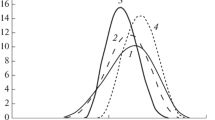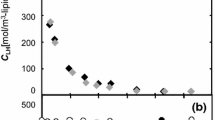Abstract
The aims of this study were twofold: develop a convenient and rapid procedure for assessing the oxidizability of small quantities of glycerophospholipids in bilayers by the oxygen uptake method, and determine and compare the oxidizability of various glycerophospholipids in bilayers. Our purpose was to educidate phospholipid oxidation characteristics in membranes. The quantitative autoxidation kinetics of dilinoleoyl phosphatidylcholine (DLPC) (18∶2/18∶2) was studied in large unilamellar vesicles (LUV) in aqueous dispersions with watersoluble initiator—2,2′-azobis(2-amidinopropane) dihydrochloride—and inhibitor 2-carboxy-2,5,7,8-tetramethyl-6-chromanol. The kinetic data indicated a high efficiency of free radical production, resulting in shortening of measuring time; the very low kinetic chain length, particularly in the induction period, suggested the possibility of including large errors in thekinetics data. Nevertheless, the autoxidation of DLPC obeyed the classic rate law: R p =k p [LH]R 1/2 i /(2k t )1/2 (where R p -rate of oxygen consumption, k p =rate constant for chain propagation, [LH]-substrate concentration; R 1/2 i -square root of rate of chain initiation, and 2k t =rate constant for chain termination) in a mixed bilayer system with saturated dimyristoyl PC (14∶0/14∶0), which provided precise and reproducible data. Therefore, the system was used to assess the relative oxidizability of each glycerophospholipid DLPC (18∶2/18∶2), dilinolenoyl PC (18∶3/18∶3), 1-palmitoyl-2-linoleoyl PC (16∶0/18∶2), 1-palmitoyl-2-arachidonoyl PC (16∶0/20∶4), 1-palmitoyl-2-docosahexaenoyl PC (16∶0/22∶6), and dilinoleoyl PE (18∶2/18∶2) in bilayers. The results suggested that the oxidizability of glycerophospholipid in bilayers is substantially influenced by the number of intramolecular oxidizable acyl chains and the content of bis-allylic hydrogen in a structured environment, and showed deviation of the rate law for autoxidation in PC and PE mixed LUV, which possibly was due to nonhomogeneous phospholipid distribution in vesicles.
Similar content being viewed by others
Abbreviations
- AAPH:
-
2,2′-azobis(2-amidinopropane) dihydrochloride
- DLPE:
-
dilinoleoyl phosphatidylethanolamine
- DLnPC:
-
diliiolenoyl phosphatidylcholine
- DLPC:
-
dilinoleoyl phosphatidylcholine
- DMPC:
-
dimyristoyl phosphatidylcholine
- DOPPE:
-
droleoyl phosphatidylethanolamine
- kcl:
-
kinetic chain length
- [LH]:
-
substrate concentrations
- LUV:
-
farge unilamellar vesicles
- PLAPC:
-
1-palmitoyl-2-arachidonoyl phosphatidylcholine
- PDPC:
-
1-palmitoyl-2-docosahexaenoyl phosphatidylcholine
- PLPC:
-
1-palmitoyl-2-linoleoyl phosphatidylcholine
- Trolox:
-
2-carboxy-2,5,7,8-tetramethyl-6-chromanol
References
Armstrong, D., Sohol, R.S., Cutler, R.G., and Slater, T.F. (1984) Free Radicals in Molecular Biology, Aging and Disease, Raven Press, New York.
Barclay, L.R.C., and Ingold, K.U. (1981) Autoxidation of Biological Molecules. 2. The Autoxidation of a Model Membrane. A Comparison of the Autoxidation of Egg Lecithin Phosphatidylcholine in Water and in Chlorobenzene, J. Am. Chem. Soc. 103, 6478–6485.
Yamamoto, Y., Niki, E., Kamiya, Y., and Shimasaki, H. (1984) Oxidation of Phosphatidylcholines in Homogeneous Solution and in Water Dispersion, Biochim. Biophys. Acta 795, 332–340.
Barclay, L.R.C., Bailey, A.M.H., and Kong, D. (1985) The Antioxidant Activity of α-Tocopherol-Bovine Serum Albumin Complex in Micellar and Liposome Autoxidations, J. Biol. Chem. 260, 15809–15814.
Howard, J.A., and Ingold, K.U. (1967) Absolute Rate Constants for Hydrocarbon Autoxidation. VI. Alkyl Aromatic and Olefinic Hydrocarbons, Can. J. Chem. 45, 793–802.
Howard, J.A. (1972) Absolute Rate Constants for Reactions of Oxylradicals, Adv. Free Radical Chem. 4, 49–173.
Niki, E., Saito, M., Yoshikawa, Y., and Kamiya, Y. (1986) Oxidation of Lipids. XII. Inhibition of Oxidation of Soybean Phosphatidylcholine and Methyl Linoleate in Aqueous Dispersions by Uric Acid, Bull. Chem. Soc. Jpn. 59, 471–477.
Barclay, L.R.C., Locke, S.J., MacNeil, J.M., VanKessel, J., Burton, G.W., and Ingold, K.U. (1984) Autoxidation of Micelles and Model Membranes. Quantitative Kinetic Measurements Can Be Made by Using Either Water-Soluble or Lipid-Soluble Initiators with Water-Soluble or Lipid-Soluble Chain-Breaking Antioxidants, J. Am. Chem. Soc. 106, 2479–2481.
Maeba, R., Shimasaki, H., and Ueta, N. (2001) Generation of 7-Ketocholesterol by a Route Different from the Decomposition of Cholesterol 7-Hydroperoxide, J. Oleo Sci. 50, 109–119.
Niki, E. (1990) Free Radical Initiators as Source of Water- or Lipid-Soluble Peroxyl Radicals, in Methods in Enzymology (Packer, L., ed.), Vol. 186, pp. 100–108, Academic Press, San Diego.
Barclay, L.R.C., Baskin, K.A., Kong, D., and Locke, S.J. (1987) Autoxidation of Model Membranes. The Kinetics and Mechanism of Autoxidation of Mixed Phospholipid Bilayers, Can. J. Chem. 65, 2541–2550.
Barclay, L.R.C., Kong, D., and VanKessel, J. (1986) Autoxidation of Phosphatidylcholines Initiated with Dicumylhyponitrite in Solution and in Bilayers, Can. J. Chem. 64, 2103–2108.
Yamamoto, Y., Niki, E., and Kamiya, Y. (1982) Quantitative Determination of the Oxidation of Methyl Linoleate and Methyl Linolenate, Bull. Chem. Soc. Jpn. 55, 1548–1550.
Cosgrove, J.P., Church, D.F., and Pryor, W.A. (1987) The Kinetics of the Autoxidation of Polyunsaturated Fatty Acids, Lipids 22, 299–304.
Mowri, H., Nojima, S., and Inoue, K. (1984) Effect of Lipid Composition of Liposomes on Their Sensitivity to Peroxidation, J. Biochem. 95, 551–558.
Wagner, B.A., Buettner, G.R., and Burns, C.P. (1994) Free Radical-Mediated Lipid Peroxidation in Cells: Oxidizability Is a Function of Cell Lipid Bis-allylic Hydrogen Content, Biochemistry 33, 4449–4453.
Miyashita, K., Nara, E., and Ota, T. (1993) Oxidative Stability of Polyunsaturated Fatty Acids in an Aqueous Solution, Biosci. Biotechnol. Biochem. 57, 1638–1640.
Yazu, K., Yamamoto, Y., Ukegawa, K., and Niki, E. (1996) Mechanism of Lower Oxidizability of Eicosapentaenoate Than Linoleate in Aqueous Micelles, Lipids 31, 337–340.
Koga, T., Takahashi, I., Yamauchi, R., Piskula, M., and Terao, J. (1997) Kmetic Studies on the Formation of Phosphatidylcholine Hydroperoxides in Large Unilamellar Vesicles by Azo Compounds, Chem. Phys. Lipids 86, 85–93.
Nara, E., Miyashita, K., and Ota, T., (1997) Oxidative Stability of Liposomes Prepared from Soybean PC, Chicken Egg PC, and Salmon Egg PC, Biosci. Biotechnol. Biochem. 61, 1736–1738.
Bowry, V.W. (1994) Arm-to-Arm Autoxidation in a Triglyceride: Remote Group Reaction Kinetics, J. Org. Chem. 59, 2250–2252.
Zachowski, A. (1993) Phospholipids in Animal Eukaryotic Membranes: Trasverse Asymmetry and Movement, Biochem. J. 294, 1–14.
Author information
Authors and Affiliations
Corresponding author
About this article
Cite this article
Maeba, R., Yusufu, Y., Shimasaki, H. et al. Comparison of the oxidizability of various glycerophospholipids in bilayers by the oxygen uptake method. Lipids 37, 893–900 (2002). https://doi.org/10.1007/s11745-002-0976-1
Received:
Revised:
Accepted:
Issue Date:
DOI: https://doi.org/10.1007/s11745-002-0976-1




